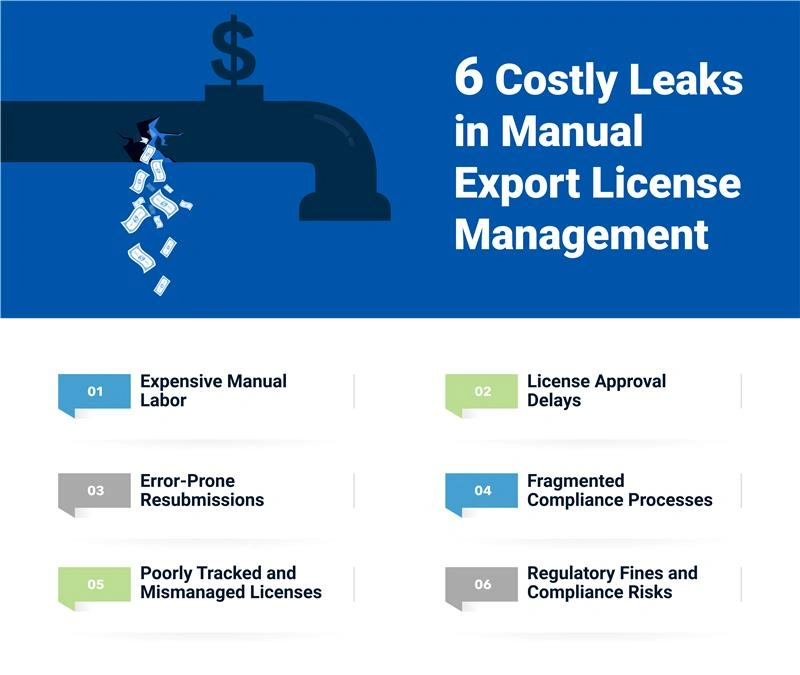Is your current approach to export license management costing you more than you realize?
Managing export licenses is an ongoing challenge for businesses operating on a global scale. While every organization strives to reduce costs and boost efficiency, determining the right steps to achieve these goals can be difficult.
Deciding whether to adopt new technology often raises questions about cost-effectiveness, and the wide range of compliance platforms available can make the decision even more complex. One common concern is whether investing in specialized export compliance software is truly necessary, especially for businesses with a dedicated in-house compliance team.
Decision-makers may reason: ‘We already have an internal export compliance team…so do we really need to pay for export compliance software?’ But does a manual, people-centric approach truly save money, or does it introduce hidden costs and inefficiencies?
Managing fewer than 10 licenses under export controls like the International Traffic in Arms Regulations (ITAR), the Export Administration Regulations (EAR), and the Office of Foreign Assets Control (OFAC) might initially seem manageable. However, the challenges quickly multiply as compliance teams must juggle export licenses across various products and stages, such as applications, approvals, resubmissions, usage tracking, expirations, and renewals. While one solution is to increase the size of your compliance team, automating the process can provide significant advantages.
Before making a decision, it’s crucial to evaluate the true cost of export license management and whether technology provides a smarter, more scalable approach for your use case. This article breaks down the factors that contribute to the total costs of manual export license management versus automated solutions, helping you choose the best path forward.
In This Article:
- What drives export licensing cost
- 6 areas where businesses lose money in export license management
- How to select export license management software that saves money
- Avoiding the glorified spreadsheet trap
- What should you pay for export license management software
- Are free government portals right for you?
- A tool that delivers clarity, control, and cost-savings
What Drives Export Licensing Costs?
Export license management costs extend beyond the upfront price of licensing fees—they include manual labor, regulatory risks, and inefficiencies that can impact your bottom line.
Businesses in highly-regulated industries like aerospace and biotechnology face stricter oversight, requiring more licenses, audits, and compliance measures. Geographic and end-user risks add another layer of complexity, as exporting to multiple countries means navigating different global export control regulations like ITAR, EAR, and OFAC and maintaining strict due diligence, which increases administrative costs. Scalability challenges also arise as businesses grow, leading to higher export licensing volumes that make manual management increasingly expensive. Finally, team efficiency and resources play a crucial role—when compliance professionals spend excessive time on human-centered processes, operational costs rise, and businesses risk delays, errors, and potential penalties.
Understanding these cost drivers is the first step to making smarter, more efficient compliance decisions. Let’s take a look at where automating export license management could help save money.
6 Areas Where Businesses Lose Money in Manual Export License Management—And How to Cut Costs
Whether you’re a growing business or an established enterprise, the way you manage export licenses can either drain resources or drive efficiency. Even the most skilled compliance teams struggle with time-consuming data entry, export license applications and approvals, usage tracking, and balances. This inefficiency can result in financial losses in the following areas:
Figure 1. 6 Ways Businesses Lose Money in Export License Management

- Expensive Manual Labor – Your compliance team spends valuable hours on repetitive tasks such as entering, tracking, and validating license data, which are not scalable. As the workload increases, so do labor costs either as overtime pay or hiring additional talent.
- How automation saves you money: Export license management software eliminates repetitive tasks, freeing up your team for strategic compliance work and reducing reliance on additional personnel which can cost upwards of $75,000 per hire.
- Approval Delays – Manually addressing regulatory requests often causes slow response times, leading to missed deadlines that can strain client relationships and result in lost revenue.
- Efficiency gains that lead to cost savings: Automated workflows and real-time notifications ensure immediate responses to regulatory agencies, keeping exports on schedule and protecting customer relationships.
- Resubmissions Due to Errors – Small mistakes in applications can cause rework, delaying shipments and increasing costs. In a manual system, correcting and resubmitting applications often means duplicating effort, re-entering data, and struggling with disjointed workflows. Worse, if an application receives an “Intent to Deny” notice, businesses must act quickly to modify and resubmit before facing outright rejection.
- Financial benefits from export license application solutions: Automation simplifies resubmissions by retaining all relevant data, documentation, and workflows in one system, allowing for seamless modifications without starting over. AI-powered validation catches errors before submission, reducing rejection rates, while built-in resubmission tools make adjustments quick and efficient.
- Disconnected Processes and Duplicated Efforts – Fragmented compliance processes and email-based workflows create communication gaps, redundant work, time wastage, and compliance vulnerabilities which drive up operational costs and feelings of frustrations for compliance teams.
- The ways automation cuts cost: A centralized export license management platform streamlines communication, ensures cross-team visibility, and eliminates redundant tasks, reducing operational waste.
- Mismanagement of Export Licenses – Failing to properly track and decrement licenses can result in shipment delays and costly fines. Reactively renewing unexpectedly expired licenses consumes valuable time and resources. Additionally, without proper balance forecasting, your business risks running out of licenses, causing further operational disruptions.
- How compliance technology protects your bottom line: Automated tracking and real-time balance forecasting prevent unexpected license expiration by identifying potential shortages or constraints before they escalate into problems.
- How compliance technology protects your bottom line: Automated tracking and real-time balance forecasting prevent unexpected license expiration by identifying potential shortages or constraints before they escalate into problems.
- Regulatory Fines & Penalties – Manual oversight increases the risk of non-compliance, leading to hefty fines, legal consequences, and even the loss of export privileges.
- Automation’s role in preventing unforeseen expenses: Export compliance software provides real-time compliance monitoring, audit trails, and proactive alerts, ensuring businesses meet regulatory requirements while avoiding expensive penalties.
How to Select Export License Management Software that Saves Money
What should you consider when selecting an export licensing solution? A cost-effective export licensing solution isn’t just about upfront pricing—it’s about cutting hidden expenses over time. Look for features that eliminate manual effort, reduce compliance risks, and prevent costly disruptions:
- Real-time Compliance Monitoring – Keeping your export operations compliant requires constant vigilance. Look out for an export license management solution with built-in compliance monitoring that:
- Automatically screens parties against global watchlists
. - Flags potential regulatory violations before they become an issue
. - Provides real-time alerts to prevent unauthorized exports
.
- Automatically screens parties against global watchlists
- Global Export License Determination: A key feature to look for in an export license management solution, this capability enables businesses to navigate export classification and multi-jurisdictional trade controls with ease. It ensures accurate and efficient export license screening, helping organizations determine requirements based on their global operations. By fostering compliance across diverse regulatory environments, this feature not only reduces risks but also empowers businesses to operate seamlessly and confidently in every market they serve.
- Automated Export License Submission & Tracking – Reduce administrative workload by selecting software that eliminates manual application processes through pre-filled application data and support for international licensing forms, as well as automated tracking, ensuring consistency across submissions and providing instant visibility into license statuses. Some export license management platforms, such as Descartes OCR Global EASEä, integrate directly with government agencies like the U.S. Department of State, enabling businesses to submit applications, track status updates, and make modifications without switching systems. This direct connection eliminates redundant data entry, reduces delays, and improves communication with regulators, ensuring faster approvals and lower compliance costs.
- Forecasting & License Optimization – Without data, managing licenses is reactive rather than strategic. Missed renewals can halt shipments and cause compliance violations. Prioritize a system with advanced analytics and automated usage/expiry notifications that help with:
- Predicting upcoming licensing needs based on export activity to avoid unnecessary purchases or disruptions due to overuse
- Provides insights into licensing bottlenecks, approval timelines, and usage trends
- Provide visibility into upcoming expirations across all active licenses
- Notify teams before license expirations, ensuring timely renewals and track pending renewal requests, preventing shipment delays
.
- Centralized Audit Trails – Government audits require accurate and comprehensive historical records, making it essential to have a robust export license management system that maintains a complete audit history of approvals, modifications, and renewals, ensuring that every detail is accurately documented. The system should also offer on-demand access to export compliance documentation, enabling organizations to retrieve necessary records quickly and efficiently. With these capabilities, businesses can confidently navigate audits and investigations, without scrambling for scattered records.
- Incident Management – Quickly address compliance risks, track corrective actions, and maintain documentation for regulatory inquiries.
- Modular Export Licensing Tools: Choosing a modular export compliance solution gives your business the tools it needs to simplify and streamline critical parts of the export licensing process, including application submissions, export document management, classification and usage monitoring. By focusing on specific areas of improvement, a modular system reduces inefficiencies and enhances productivity across your operations. It delivers long-term savings through optimized resource allocation.
- Seamless Integration with Compliance Workflows: Disconnected systems lead to compliance gaps and inefficiencies. An integrated export license management solution:
- Embeds into ERP, CRM, and government portals (DECCS, BIS, OFAC)
- Links license data to shipment and order processing systems
. - Ensures a single source of truth for export compliance
.

Avoiding the ‘Glorified Spreadsheet’ Trap
Not all export license management tools truly automate compliance—some are little more than glorified tracking spreadsheets. These solutions may lack integration with trade compliance workflows, forcing teams to manually fill in gaps, increasing labor costs and compliance risks.
Red flags to look out for when evaluating export license management software:
- Watch out for limited automation and disconnected workflows – If a system still requires heavy manual input, it’s not solving your problem.
- Overreliance on ‘feature List’ – A long list of features may look impressive but may not reflect how well the software functions in practice. Always request a live demo to verify true automation and usability.
- Insufficient coverage for global licensing needs – For businesses navigating multiple markets, be cautious of what international licensing features offer. At the minimum, the system should provide pre-configured export license forms with local language support to guarantee alignment with regulatory portals.
- Inadequate support and training – Insufficient onboarding resources or lack of customer support could leave your team struggling to make the most of the software. Check reviews on platforms like G2 and Capterra to get real insights from businesses with similar needs.
What Should You Expect to Pay for Export License Management Software?
Understanding the cost structure of an export license management solution is crucial for budgeting effectively. While pricing varies based on your business’s specific needs, here are key factors to consider:
1. User Licenses: How Many Users Need Access?
- Per-User vs. Volume-Based Pricing: Some solutions charge per user, while others offer tiered pricing for larger teams. Pricing can start as low as $600 per year per user but may increase significantly based on the size of your compliance team. Determine the number of users in your organization who require software access, considering their role in the export compliance process, to minimize costs while upholding compliance standards.
2. Activity Level & Export Compliance Scope
The complexity of your export operations directly impacts costs. Businesses dealing with multiple regulatory agencies may need more robust functionality such as several export licensing modules for:
- State Department Licensing (DDTC) – Required for defense-related exports.
- Department of Commerce / BIS Licensing – Covers dual-use goods and technology.
- OFAC Licensing – Needed for businesses operating in sanctioned regions.
- Global Licensing Needs (EU, UK, etc.) – Varies by jurisdiction and regulatory body.
3. Server & Data Storage Fees
Cloud-Based vs. On-Premise: Cloud solutions may include hosting and security updates, while on-premise deployments often require higher upfront investment and ongoing maintenance fees.
4. Integrations: Connecting to Your Tech Stack
ERP, CRM, and Logistics Integrations – Connecting with platforms like SAP, Oracle, and Salesforce can improve efficiency but may come with additional implementation costs.
5. Hidden Costs to Watch Out For
Avoid unexpected expenses by clarifying these cost factors upfront:
- Implementation Fees – Best-in-class vendors provide a Statement of Work (SOW) to outline deployment costs and timelines.
- Compliance Team Training – Leading solutions include free training and onboarding resources to ensure smooth adoption.
Ongoing Support & Updates – Some providers include customer support in the base price, while others charge extra for continued assistance.

Free Government Portals vs. Paid Export Licensing Software: Which Is Right for Your Business?
Government agencies offer free online portals, such as the European Union (EU) Customs Trader Portal, the Bureau of Industry and Security’s (BIS) Simplified Network Application Process – Redesign (SNAP-R), and the DDTC Defense Export Control and Compliance System (DECCS), to help businesses manage export licenses and streamline the application process. These tools are designed for basic submissions, not for full compliance management.
As businesses expand, free government portals often create operational bottlenecks that hinder efficiency. Managing multiple applications across global markets becomes increasingly time-consuming, while manual workflows without built-in compliance checks raise the risk of errors. For companies operating in heavily-regulated industries, the complexity of compliance requires more robust solutions. Even organizations in less regulated sectors may need advanced reporting capabilities and flexibility to handle growing demands.
Paid export licensing solutions address these gaps by offering tailored features like automation, multi-jurisdictional tracking, and scalability, ensuring businesses can maintain compliance as they expand into new markets. Investing in the right solution empowers organizations to save time, reduce risks, and operate with greater confidence.
Achieve Clarity, Control, and Cost– Savings with Descartes Export License Management Solutions
In today’s fast-paced global trade environment, reducing export licensing fees isn’t just a cost-saving strategy—it’s a necessity for maintaining competitive advantage. By automating key processes with the right technology, businesses can reduce manual labor, eliminate costly errors, accelerate approvals, and achieve global compliance coverage seamlessly.
Descartes Export License Management solutions deliver unparalleled flexibility and functionality. For a truly comprehensive approach, the Descartes OCR Global Ease solution offers an all-in-one platform for applying, tracking, and managing export licenses. With direct integration into government portals, it removes inefficiencies while ensuring full compliance with regulatory requirements. Its modular capabilities, including Export Operations, Authorization Management, Denied Party Screening, and Forced Labor Risk Management, allow businesses to tailor the solution to their needs, scaling effortlessly as they grow.
Now is the time to evaluate your export licensing operations and uncover hidden inefficiencies that could be costing your business more than you realize. Ready to reduce fees, eliminate inefficiencies, and keep your exports moving without delays? Request a demo to see how our solutions can transform your export operations.
Don’t wait—experience the technology that’s built to grow with you while reducing export licensing fees and complexity.




